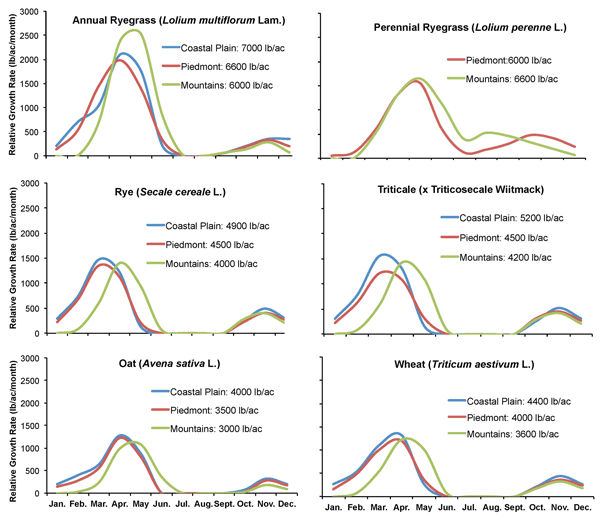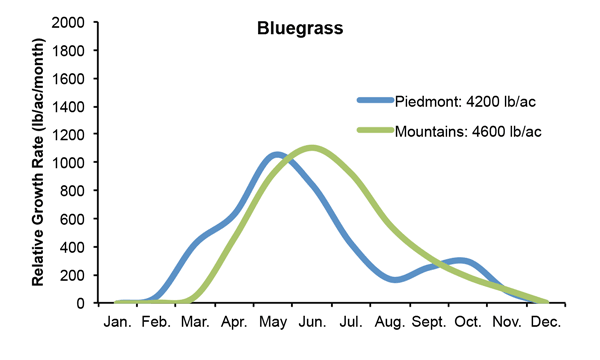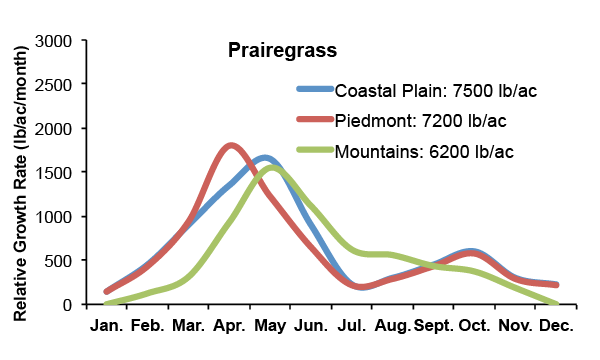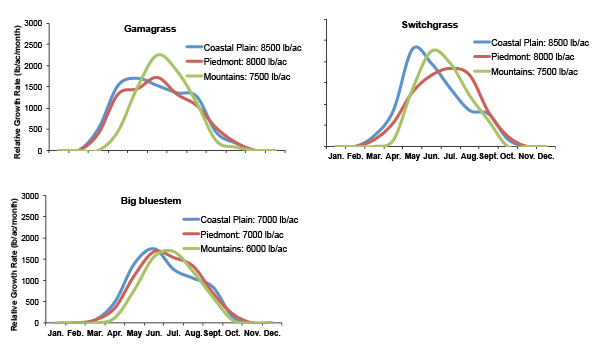Essential Nutrients and the Principle of the Limiting Factor
Forages, as all other plants, require seventeen elements for normal growth and completion of their life cycle (Table 1). The amount of plant nutrient required varies by nutrient and by plant. For example, all plants have a greater need for nitrogen (N), phosphorus (P), and potassium (K) than they do for boron (Bo), molybdenum (Mo), and nickel (Ni). Some forages, such as alfalfa, have greater need for Bo than other forages such as tall fescue and corn.
Carbon (C), hydrogen (H), and oxygen (O) are non-mineral nutrients that are used in greatest amounts by plants and are supplied by air and water. Mineral nutrients can be supplied by the soil or fertilizers and are classified based on the relative amounts needed by plants. Minerals required in greatest amounts are termed primary macronutrients, followed by secondary macronutrients, and those required in least amounts are termed micronutrients. If any of these essential nutrients are limiting, then plant growth and overall productivity will be limited to the level that the most limiting nutrient will allow. This concept is referred to as Liebeg’s law of the minimum.
|
Element |
Symbol |
Primary Forms Used by Plants |
|
|
NON-MINERAL ELEMENTS |
|
||
|
Carbon |
C |
CO2 |
|
|
Hydrogen |
H |
H2O |
|
|
Oxygen |
O |
CO2 |
|
|
MINERAL ELEMENTS |
|
||
|
Primary Macronutrients |
|||
|
Nitrogen |
N |
NH4+, NO3- |
|
|
Phosphorus |
P |
HPO42-, H2PO4- |
|
|
Potassium |
K |
K+ |
|
|
Secondary Macronutrients |
|
||
|
Calcium |
Ca |
Ca2+ |
|
|
Magnesium |
Mg |
Mg2+ |
|
|
Sulfur |
S |
SO42- |
|
|
Micronutrients |
|||
|
Iron |
Fe |
Fe3+, Fe2+ |
|
|
Manganese |
Mn |
Mn2+ |
|
|
Zinc |
Zn |
Zn2+ |
|
|
Copper |
Cu |
Cu2+ |
|
|
Boron |
B |
B(OH)3 |
|
|
Molybdenum |
Mo |
MoO42- |
|
|
Chlorine |
Cl |
Cl- |
|
|
Nickel |
Ni |
Ni2+ |
|
|
Source: Havlin et al. 2005. Soil Fertility and Fertilizers: An Introduction to Nutrient Management. (7thed.) Upper Saddle River, NJ: Pearson Prentice Hall. |
|||
Soil Test Interpretation and Fertilization Rates
Fertilization of forages in North Carolina is based on the concept of sufficiency nutrient soil levels, meaning that you want to maintain fertility levels such that none of the essential nutrients limit forage growth. Through field trials and greenhouse studies, soil test calibrations were completed and fertilizer recommendation models were developed. When the soil test levels are sufficiently high, no yield response to the addition of fertilizer is expected, so no nutrients are recommended. For soils with low concentrations, fertilizer is recommended. For soils with intermediate concentrations, fertilizer is recommended but at a rate lower than that in the low soil fertility scenario. For North Carolina growers, soil testing service is provided by the Agronomic Division of the North Carolina Department of Agriculture and Consumer Services (NCDA&CS) (a link is provided in the website resources section). The Agronomic Division currently makes fertilizer recommendations for ninety different crops grown in North Carolina.
Soil Test Index System
With the exception of N, soil test results for P, K, sulfur (S), manganese (Mn), zinc (Zn), and copper (Cu) are reported as index values for ease of interpretation (Table 2). Index values can be converted to a quantitative equivalent (Table 3). Calcium and magnesium (Mg) are reported as percentages of the soil cation exchange capacity (CEC).
| Soil Test Index | Interpretation | |
| Index Range | Fertility Rating | |
|
0–10 |
Very Low |
Yield increase is expected by application of the recommended nutrient. A large portion of the nutrient requirement must come from fertilization. Expect 50% (or less) crop yield potential if recommended nutrients are not applied. |
|
11–25 |
Low |
Yield increase is expected by application of the recommended nutrient. A large portion of the nutrient requirement must come from fertilization. Expect 50 to 70% crop yield potential if recommended nutrients are not applied. |
|
26–50 |
Medium |
Yield increase is expected by application of the recommended nutrient. A small portion of the nutrient requirement must come from fertilization. Expect 75 to 100% crop yield potential if recommended nutrients are not applied. |
|
51–100 |
High |
Yield increase to the added nutrient is not expected. No additional fertilizer is needed. |
|
100+ |
Very High |
Yield increase is not expected. Additional fertilizer should not be added to avoid nutritional problems and adverse environmental consequences |
| Adapted from Circular No. 1, NCDA&CS (Hardy et al., 2014). | ||
| Index Value | Multily by the conversion factor to obtain lb/ac1 |
| p2 | 2.138 |
| K2 | 3.484 |
| Mn | 0.07 |
| Zn | 0.071 |
| Cu | 0.036 |
| S | 0.857 |
| Na | 409.86 |
| Ca% x CEC | 356.4 |
| Mg% x CEC | 216.69 |
| Adapted from Hardy et al. 2014. Circular No. 1, NCDA&CS. | |
|
1 Conversion factor is based on one acre furrow slice (46,560 sq ft to a depth of 7.9 inches) = 2,000,000 lb of soil. |
|
Nitrogen Fertilization Rate
Nitrogen application rate recommendations are based on the concept of realistic yield expectation (RYE). The RYE estimates are based on the average three best years in a five-year period that could be achieved with a high level of management (top 20% of growers). Soil is one of the factors that can influence RYE. To determine the soil type on your farm, consult the online Web Soil Survey. To determine RYE and N application rates based on your specific soil type, access the North Carolina RYE database. Nitrogen recommendations on soil test reports are general recommendations based on historical research in North Carolina.
Fertilization Rates
In order to calculate the fertilizer rate (lb/ac) for each crop, index values from the soil analysis are entered into the appropriate model equations developed for North Carolina. The model equations developed by crop for establishment and maintenance scenarios are described by Hardy et al. (2014).
Nutrient Management Guidelines
Specific nutrient management recommendations by crop are provided in Appendix 1.
Fertilizers, including waste products containing nutrients, are generally best applied during the periods of active forage growth to maximize nutrient uptake, productivity, and competition against weeds. This is especially true for N, K, and S. Phosphorus can usually be applied at any time during the growing season because it is immobile in soils. If P requirements are high at the time of planting, better results will be attained by incorporating P into the top 4 to 6 inches of soil when preparing a seedbed for planting.
Depending of the type of forage and the location in the state, periods of active forage growth/re-growth differ (see Forages for North Carolina: General Guidelines and Concepts), and fertilization requirements may also differ. In general, soil amendments can be applied one month earlier in the eastern part of the piedmont and coastal plain regions compared to the mountains. For farms utilizing animal waste as a nutrient source, manure applications cannot be made more than 30 days before planting or breaking dormancy.
Split-application of fertilizer, especially N, K, and S, should increase the efficiency of utilization. This is especially important for intensively used pastures and sites in sandy soils. For example, in hay production systems the total N rate can be split-applied after each harvest to ensure high nutritive value of the harvested forage. Nevertheless, split application may not always be necessary or possible. Since S is a companion nutrient to N and helps N utilization by plants, S is best applied when N is applied.
When the micronutrients Mn, Zn, and Cu soil test levels are low for most forage crops, NCDA&CS does not give a recommendation because a response to their application is uncertain. Plant tissue testing can provide insight as to the sufficiency of these nutrients as well as overall plant nutrition, so it should be a part of pasture management. Additionally, plant monitoring is important on sites where Zn and Cu levels have increased due to routine application of animal or poultry waste.
As with any fertilizer program, management of soil pH is critically important because it controls nutrient availability, alleviates soil acidity, and provides an environment for biotic micro- and macroorganisms to flourish, thus enhancing soil productivity. Lime should be applied only on the basis of a current soil test. Dolomitic lime supplies Ca and Mg and is most useful in sandy coastal plain soils where Mg leaching may occur. Further information for liming can be found in Soil Facts: Soil Acidity and Liming for Agricultural Soils.
Grazing vs. Hay production
In grazing systems, 60% to 90% of the consumed nutrients may be returned to the pasture in the form of dung or urine (Haynes and Williams 1993; Franzluebbers et al. 2004). Nitrogen fertilization rates for grazing systems may be reduced by 25% and 50% of the recommended rate for hay production for continuous- and rotational-stocking, respectively. For fields receiving manure applications, the N application rate in grazed systems must be reduced by 25%. Contrary to grazing systems where nutrients are recycled, the majority of nutrients in hay production systems are removed from the system at harvest in the plant tissue. For estimated crop nutrient removals in North Carolina, please see Soil Facts: Nutrient Removal by Crops in North Carolina.
Cool-season forages
For perennial grass forages such as fescue, orchardgrass, and bluegrass, apply half of the N rate in mid-February to March for spring growth and the other half in mid-August to September for fall growth. Mid-August is best for western piedmont and mountain pastures. September is best for the eastern piedmont and coastal plain. The application timing of N for pure grasses is different than for P2O5 and K2O. Nitrogen is generally used or possibly lost (through leaching or volatilization) within six to eight weeks after application; therefore, split applications at planting and in the subsequent growing seasons are recommended. Fall planting of grasses would require up to 60 lb N/ac at planting and the additional maintenance application for the subsequent spring and fall. Thus, the annual amount of N recommended by the soil test report should be split-applied in two to three applications. See specific N, P2O5, and K2O recommendations for forage fertilization in the Appendix.
For winter annual grasses such as ryegrass, rye, oats, wheat, barley, and triticale, split-apply N into two to three applications. For annual ryegrass, N may be applied one-third at planting in September-October, one-third in February to March, and one-third in early April. Small grains should not receive N after mid-March unless the subsequent crop has the potential to use it.
Warm-season forages
For perennial grass forages, such as bermudagrass, dallisgrass, switchgrass, indiangrass, big bluestem, and gamagrass, split-application in two to three applications of N is recommended. If production is mainly for hay, it is recommended to split-apply the total recommended N rate between cuts (generally every four to six weeks between cuttings). Phosphate and potash may be applied in early April when growth begins; however, on sandy soils 50% K2O should be split-applied in two applications.
For annual forages, such as pear millet, sorghum sudan (sudangrass), and crabgrass, an evenly divided N application is recommended at planting and every four to six weeks, or after each cutting, up through August. Phosphate and potash should be applied at planting.
Legumes
The recommended amount of nitrogen for establishment is usually 10 to 30 lb/ac; however, the recommendation for maintenance is zero, assuming that adequate nodulation of the legumes’ roots exists for N fixation. Make sure seeds are inoculated prior to planting legumes. For cool-season legumes, such as alfalfa (perennial) or red clover (annual), P2O5 and K2O may be applied in March or late autumn. In sandy soils, apply 50% of K2O after the second cutting. Boron may be applied with the first spring application of P2O5 and K2O or applied with insecticide on alfalfa. For warm-season legumes, such as lespedeza (perennial), apply the fertilizer in spring. Total fertilizer rates should be based on the results of the soil test.
Grass-legume mixtures
A functional grass-legume mixture is generally considered to contain at least about 35% legume of the total biomass. Common perennial cool-season mixtures include white clover in combination with tall fescue, orchardgrass, prairegrass, and Kentucky bluegrass. Phosphate and potash may be applied in the spring (February to March) or fall. Nitrogen fertilization is generally not required in grass-legume mixtures because it is expected that legumes will provide N through the N2 atmospheric fixation process. The application of N fertilizer may, however, shift the balance of the mixture by encouraging grass growth over the legume.
Resources
- Soil Testing: Agronomic Division, North Carolina Department of Agriculture & Consumer Services
- Agronomic notes, North Carolina Department of Agriculture & Consumer Services.
- Forages North Carolina – N.C. Cooperative Extension
- Nutrient Management in North Carolina
- Realistic Yield Expectations for North Carolina Soils
- Web Soil Survey
References
Castillo, M.S., J.P. Mueller, and J.T. Green. 2014. Forages for North Carolina: General Guidelines and Concepts. AG-789. Raleigh, NC: North Carolina Cooperative Extension Service. A
Crozier, C, and D.H. Hardy. 2003. Soil Acidity and Liming for Agricultural Soils. AGW-439-50. Raleigh, NC: North Carolina Cooperative Extension Service.
Franzluebbers, A.J., S.R. Wilkerson, and J.A. Stuedemann. “Bermudagrass management in the Southern Piedmont USA: X. Coastal productivity and persistence in response to fertilization and defoliation regimes.” Agron. J. 96 (2014): 1400–1411.
Haynes, R.J., and P.H. Williams. “Nutrient cycling and soil fertility in the grazed pasture ecosystem.” Adv. Agron. 49 (1993): 119–199.
Hardy, D.H., M.R. Tucker, and C.E. Stokes. 2014. Crop fertilization based on North Carolina soil tests. Raleigh, NC: North Carolina Department of Agriculture and Consumer Services, Agronomic Division. Circular No. 1.
Havlin, J.L., S.L. Tisdale, J.D. Beaton, and W.L. Nelson. 2005. Soil Fertility and Fertilizers. Upper Saddle River, NJ: Pearson Education, Inc.
Osmond, D.L., and J. Kang. 2008. Nutrient Removal by Crops in North Carolina. AG-493-16W. Raleigh, NC: North Carolina Cooperative Extension Service.
Appendix 1. Specific Nutrient Management Recommendations
Cool-season forages
- Alfalfa
- Annual winter-grazing forage (ryegrass; small grains: rye, oats, wheat, barley)
- Annual winter-silage forage (smallgrains: rye, wheat, oats, barley, triticale)
- Bluegrass
- Grass-legume mixtures (white clover + tall fescue, + orchardgrass, + prairegrass)
- Tall fescue, orchardgrass, timothy
- Prairegrass
Warm-season forages
- Annual warm-season grazing forages (sorghum sudangrass, pearl millet, crabgrass)
- Annual warm-season silage forages (sorghum sudangrass, sorghum)
- Bahiagrass, Bermudagrass
- Gamagrass, Switchgrass, Big Bluestem
Nutrient management recommendations:
- Target soil pH: 6.5
- Nitrogen is rarely justified on legumes, except when planting into N deficient soils or when the seedling plants are not sufficiently inoculated with the proper rhizobia. Under such conditions, apply up to 30 lb/ac at planting or after seedling emergence if plants show signs of poor nodulation.
- Apply recommended P2O5 and K2O in late March or late August.
- On sandy soils, split-apply the recommended K2O rate in two applications (early- and by mid-season).
- Boron may be applied with the first spring application of P2O5 and K2O or applied with insecticide on alfalfa.
- Molybdenum is a micronutrient required for symbiotic N fixation. For soils inherently low in Mo, apply at a rate of 0.25 to 0.5 lb/ac.
Nutrient management recommendations:
- Target soil pH: 6.0
- Nitrogen rates are usually 80 to 100 lb/ac. For small grains grown on sandy coastal plain soils where nitrogen is subject to leaching, apply 20 to 30 lb N/ac at planting with the remainder top-dressed in late February or early March. On heavy-textured soils of the piedmont and mountains, apply one-third at planting and topdress with the remainder in late February or early March.
- P2O5 and K2O may be applied at planting (September to October), and K2O may also be split-applied with N fertilization.
- Sulfur deficiency may occur on small grains, especially on deep sandy soils, after leaching rainfall. Frequent monitoring by taking tissue samples is encouraged.
Nutrient management recommendations:
- Target soil pH: 6/0
- Nitrogen rates are usually 80 to 100 lb/ac. Split N rate in two to three applications (one-third at planting in September to October), one-third February to early March, and one-third in early April), especially for the sandy soils of the coastal plain. On heavy-textured soils of the piedmont and mountains, apply one-third of the recommended rate at planting and the remainder in late February or early March. Small grains should not receive N after mid-March, unless the subsequent crop has the potential to use it.
- P2O5 and K2O may be applied at planting (September to October), and K2O may also be split-applied with N fertilization.
Nutrient Management Recommendations:
- Target soil pH: 6.0
- Nitrogen rates are usually 100 to 120 lb/ac and should be split-applied in halves between mid-April and mid-June.
- P2O5 rate should be applied in spring (April).
- K2O may be applied at full rate in spring or split-applied with N fertilization.
Nutrient management recommendations:
- Target soil pH: 6.5
- Nitrogen recommendation is usually 10 to 30 lb/ac for establishment and zero for maintenance. A functional grass-legume mixture is generally considered to contain at least about 35% legume of the total biomass. The legume component is expected to fix atmospheric N into the system, thus benefitting both the legume and the grass components from this fixation. When there is plenty of N in the system, the grass will dominate; when there is limited N in the system, the legume component will thrive.
- P2O5 and K2O may be applied at ratio of 1:2 or 1:3 in the spring (February to March) or fall.
Nutrient management recommendations:
- Target soil pH: 6.0 to 6.5
- Nitrogen rates are usually 100 to 200 lbs/ac. If pasture is to be used for grazing, reduce the N rate by 25% if animals are continuously stocked or by 50% if rotationally stocked. For hay or silage, apply the full-recommended rate. If the N rate ranges between 50 to 100 lb/ac/yr, split the N application into two applications (February to March and August to September). If more than 150 lb/ac is recommended, split apply N into three applications (February to March, April, and late August to September).
- P2O5 and K2O may be applied in spring (February to March) or in autumn (August to September).
Nutrient management recommendations:
- Target soil pH: 6/0
- Nitrogen rates are usually 120 to 200 lb/ac. If the N rate ranges between 50 to 100 lb/ac/yr, split the N application into two applications (February to March and August to September). If more than 150 lb/ac is recommended, split apply N into three applications (February to March, April, and late August to September).
- P2O5 and K2O may be applied in spring (February to March) or in autumn (August to September).
Nutrient management recommendations:
- Target soil pH: 6.0
- Nitrogen recommendations are usually 140 to 180 lb/ac. Apply 50 to 70 lb/ac at or before seeding and the remainder in increments of 40 to 60 lb after each cutting or grazing period up through August.
- P2O5 and K2O may be applied at planting, and K2O may be split-applied with N fertilization, especially in deep, sandy soils.
Nutrient management recommendations:
- Target soil pH: 6.0
- Nitrogen recommendations are usually 140 to 180 lb/ac. Apply 50 to 70 lb/ac at or before seeding and the remainder in increments of 40 to 60 lb after each cutting or grazing period up through August.
- P2O5 and K2O may be applied at planting, and K2O may be split-applied with N fertilization, especially in deep sandy soils.
Nutrient Management Recommendations
- Target soil pH: 6.0
- Nitrogen rates are usually 60 to 80 lb/ac for the establishment period and 180 to 220 lb/ac for maintenance and production. If pasture is used for grazing, then reduce the N rate by 25% if animals are continuously stocked or 50% if rotationally stocked. If pasture is used for hay production, then split-apply the annual rate after each harvest, or when growth begins, and every four to six weeks (normally a total of four to five cuts can be achieved during the production season).
- P2O5 and K2O may be applied in early April when growth begins; however, on sandy soils 50% of the K2O rate should be applied after the second harvest or about July 1.
- Sulfur may be needed for bermudagrass growing on some coastal plain soils at about 50 lb/ac/yr.
Nutrient management recommendations:
- Target soil pH: 6.0
- Nitrogen rates are usually 180 to 220 lb/ac for gamagrass and 120 to 160 lb/ac for switchgrass. Nitrogen should be split-applied in halves between mid-April and mid-June.
- P2O5 rate should be applied in spring (April).
- K2O may be applied at the full rate in spring or split-applied with N fertilization.
Publication date: Feb. 19, 2015
Reviewed/Revised: Nov. 7, 2024
AG-804
N.C. Cooperative Extension prohibits discrimination and harassment regardless of age, color, disability, family and marital status, gender identity, national origin, political beliefs, race, religion, sex (including pregnancy), sexual orientation and veteran status.











